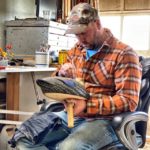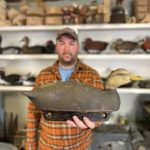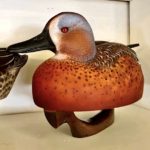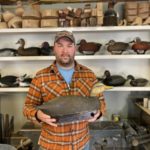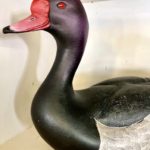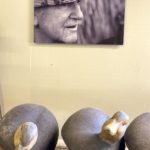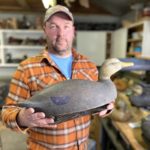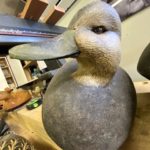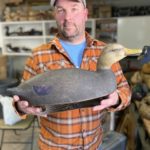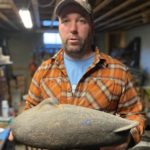New Jersey decoy carver Mike Braun tells ramsey Russell about learning duck hunting and decoy carving the old-fashioned way. He was taught by his dad at a very young age. A self-described contemporary artist, he competes at the highest levels but also builds one-of-a-kind traditional gunners distinctly reflecting his New Jersey heritage. How old was Braun when his dad starting taking him duck hunting and what was his first duck? What unique bird species at the World Show inspired him start carving, when did it become a full-time vocation, and how long does it take him to carve each decoy? What does duck hunting over his own decoys mean to him personally? Today’s Duck Season Somewhere episode takes place among saw dust piles, where wooden blocks and nail-scratched feathering become gunning rigs, meaningfully connecting people to past generations. And to waterfowl.
Related Links:
Mike Braun on New Jersey Decoy Carving and Traditional Duck Hunting
Ramsey Russell: Welcome back to another episode of Duck Season Somewhere. I’m in New Jersey. Had a great hunt this morning. We hunted out there on that marsh and shot American black ducks and Atlantic brant. Forrest and our host had a little mixed bag going with some common mergansers and hooded mergansers and buffleheads. New Jersey is a real, real interesting place. Today’s guest is Mike Braun, a resident of New Jersey and a decoy carver of epic proportions. Just thought he could really help shed some light on what New Jersey duck hunting, and duck hunting traditions, is all about. How are you doing today, Mike?
Mike Braun: I’m good, man. It’s great to have you guys here.
Ramsey Russell: Yeah. We’re glad to be here. You work in this shop regularly. This is a real carving shop, here.
Full-Time Waterfowl Decoy Carver
Mike Braun: Yeah. Full-time. Six days a week. Seven days a week, sometimes.
Ramsey Russell: Stacks of wood. The painting table where we watched you scratch a black duck’s head when we got back. Dadgum, man, sawdust. I love the smell, coming into a real decoy carver’s shop like this. It’s amazing. Where do you get your wood for stuff like this?
Mike Braun: Local sawmills. Sawmills up in New York. Pretty much. Anyway, that’s cutting decoy wood. Most of the stuff I’m carving is cedar, but I’ll get tupelo and stuff like that from the shows and whatnot.
Ramsey Russell: You were showing me some of your first decoys, green-winged teal that you and your dad did together. They were cork. You don’t do any cork decoys, anymore?
Mike Braun: No, not anymore. I don’t particularly care for cork.
Ramsey Russell: Why?
Mike Braun: I just don’t like carving it. It’s messy. It’s dirty. It actually takes more time to carve a cork bird than it does to carve a wood bird, so.
Ramsey Russell: Really?
Mike Braun: Yeah, because you’ve got a lot of finishing and prepping for paint, at least the way I would make a cork bird. I don’t like painting on all the holes, so you fill all them holes in and everything. Every once in a while I’ll do a cork bird, but not too much.
Ramsey Russell: You obviously duck hunt though, right?
Mike Braun: Yeah.
Dad Taught Mike Braun to Hunt Ducks and Carve Decoys in New Jersey
All I remember, is hunting season coming around and him working on decoys. I was his shadow. He’s the one that gave me the bug to do it all. It’s pretty much ingrained in me.
Ramsey Russell: Talk about your childhood, Mike. How did you get into duck hunting? Who got you into duck hunting? What was it like duck hunting when you got started?
Mike Braun: My father was the one that got me into everything I do in the outdoors, from fishing to hunting. There’s a photo my dad took, and I was six years old in a sneakbox.
Ramsey Russell: Really?
Mike Braun: Yeah. I don’t remember me ever shooting a bird that day. But that’s all I remember, is hunting season coming around and him working on decoys. I was his shadow. He’s the one that gave me the bug to do it all. It’s pretty much ingrained in me, as far as that aspect of it.
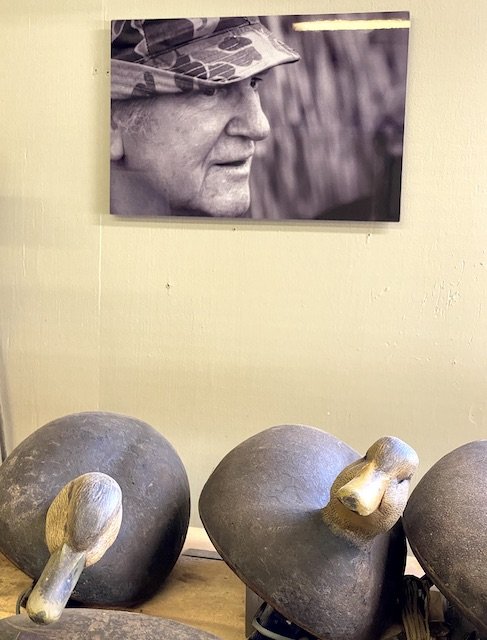
Ramsey Russell: Do you remember your first duck?
Mike Braun: My first duck? Yeah. It was a wood duck.
Ramsey Russell: Really? Here in New Jersey?
Mike Braun: Actually, my first season shooting, I didn’t shoot anything. It took me ’till my second season to finally shoot a duck. It was a hen wood duck. I remember that.
Ramsey Russell: I’ll be danged. That’s pretty interesting. Did your dad also get you into carving?
Mike Braun: Yes. My dad carved. He learned from a local fellow. Then he took it, and he would sell all his decoys at the shows and stuff. This is how I got wrapped up in wanting to carve: I was eight or nine years old, and I went to the World Show. I saw this huge emperor penguin that this ten year old kid carved, and I was obsessed with it. I kept tugging on my dad’s shirt and saying, “Dad, you gotta see this. You gotta see this.” Finally, halfway through the show, he’s like, “All right, come on.” I showed it to him. He’s like, “Well, you can do that.” I said, “Really?” He said, “Yeah.” So that summer I started on my first bird, which was a little green-winged teal.
Ramsey Russell: Did your dad carve competitively?
Mike Braun: Very little. He entered some local shows, but he wasn’t as highly competitive as you would like to see in the World Show or Ohio Show or anything like that.
Ramsey Russell: So he carved gun rigs?
Mike Braun: He carved strictly gunning decoys.
Ramsey Russell: For himself? For locals?
Mike Braun: For himself and locals.
Ramsey Russell: How long ago would that have been, Mike? ‘70s, ‘80s?
Mike Braun: Oh yeah, absolutely.
Ramsey Russell: Is that when he started carving?
Mike Braun: ‘70s. I was a kid. He was carving probably before I even knew what he was doing.
Ramsey Russell: Did he ever hunt over plastics?
Mike Braun: I’m sure when he first started going out he hunted over plastics. Actually, the first birds he made were broadbill and canvasback rigs that were just cork bodies with Herter’s heads on them. Yeah, he carved the bodies and put Herter’s heads on them. Yeah. Then he just moved on from there.
Ramsey Russell: What was it like? Were most people hunting over hand-carved rigs, back then? That’s my impression.
Mike Braun: Yes. It’s not like the industry today with all the people making plastic decoys. The plastic decoys that were out in the ‘70s and ‘80s—it was like Flambeau, and I don’t know if it was Carry-Lite, but it was like the Italy-made decoys.
Ramsey Russell: I remember Carry-Lite. I’ve got a close friend, back home, that still hunts over a 25 year-old pair of Carry-Lite.
Mike Braun: Yeah. They still work.
Ramsey Russell: Yeah, sure. Of course they do.
Mike Braun: But yeah, guys that wanted something that looked a little bit more lifelike went to their local carvers. The Tuckerton Show—that’s all it used to ever be, was just decoy carvers. It’s changed a lot over the years, but it’s still a big tradition here for local carvers to be selling their birds to gun over.
Traditional New Jersey Duck Hunting
If I was going to explain what a true traditional New Jersey duck hunter would be, it would be a traditional Barnegat Bay sneakbox. Hand-carved decoys. Small decoy spreads…And hunting black ducks and stuff like that.
Ramsey Russell: For a lot of listeners that aren’t from New Jersey, describe to them how y’all hunt out here. It’s a rich and colorful history, I understand, here in New Jersey.
Mike Braun: If I was going to explain what a true traditional New Jersey duck hunter would be, it would be a traditional Barnegat Bay sneakbox. Hand-carved decoys. Small decoy spreads. You’re hunting narrow ditches, running these boats up the ditches, and hunting black ducks and stuff like that. When you get to the bayfront, it’s changed since I’ve been hunting. That’s all we ever used to run, was just a Barnegat Bay sneakbox. We used to have a trailer that held two of them, and then we would tow a little pond box behind it. Two guys would go out in one, and one would hunt the box, and the other one would be in the pond box.
What’s a Barnegat Bay Sneakbox?
Ramsey Russell: What is a Barnegat Bay sneakbox?
Mike Braun: If I had to describe it—traditionally, a Barnegat Bay sneakbox was a sailing vessel. It’s very seaworthy. The average is anywhere from twelve to fourteen foot long. They would have decoy racks on the back of them that they would stack all their decoys on, and they would sail them out. We’re talking market hunting days now, too. Early 1900s. Now they fix them with motors and stuff, and they’re made out of fiberglass. There’s some guys that still make them out of wood. It’s usually just a one-man boat. You hide underneath a spray shield. The whole boat’s grassed up, obviously, and it just tucks up in the marsh. You just drive it up on the marsh, or pull it up on the marsh, and grass it all in. It would be like their version of a layout blind, back then.
Ramsey Russell: I see. You could get to the duck hole and then back it off—
Mike Braun: It would be like a jet ski on steroids, if anything.
Ramsey Russell: —into the marsh hay, they call it. Salt hay, that’s what I’ve heard that grass called out there, that spartina. Salt hay.
Mike Braun: Yeah. Everything out there is salt hay. Most of it.
Ramsey Russell: In the grass, right up there. And the pond box is similar?
Mike Braun: A pond box is actually just a coffin box. Kind of like a layout blind, right? It would just be square, but it was designed so that you could drag it across the marsh. It was very low-profile. It was really used for hunting the swamp ponds. You would get to your destination, and then you would walk—I still hunt swamp ponds, and sometimes it’s two hundred yards away from a pond you want to go to. You’re already taking six decoys, a gun, and shells, and walking out there. It’s a very mobile setup.
The Future of Duck Hunting Lies in its Past
It’s something that’s being lost, especially in this area. I think people need to look at it as not just going out and shooting ducks. It’s more: what’s the history? Where did it come from? It’s something that you don’t want to see the art of it lost. – Mike Braun, MRB Decoys Art Design
Ramsey Russell: What are some of your fondest memories growing up with your dad, hunting that real traditional way? You’re about my age, maybe a little younger. What was it like hunting those traditional methods that way, but then watching on television with all the newfangled—?
Mike Braun: It’s funny. The way I hunted with my dad—the traditional way—was with the sneakboxes, and we would only take maybe a couple dozen decoys. We both would be in one sneak box. We would hunt the bay, or we would hunt the marshes, for teal. Just some of the spots that we would get into and the lack of pressure that the birds had back then, compared to today, was phenomenal. We were shooting green-wings and blue-wings all the way through December. The duck hunting craze has developed, and then technology changes, and boats and motors have changed, so it’s easy to—
Ramsey Russell: Motors got noisier.
Mike Braun: Well, not necessarily, but you have these mud motors and stuff like that. Back then in the ‘80s, even in the ‘90s, that stuff wasn’t popular around here. Getting in that skinny water was guys with sneakboxes that could get into those places where all the ducks wanted to be.
Ramsey Russell: Now anybody can access it, with all the technology.
Mike Braun: Yes. It’s funny because as I got older—like you said, you see all the TV shows and go, “Oh, I want to try this. I want to do layout hunting. I want to do this and that.” Now that I’m older and I’m carving full-time, I find that I’m going back to the traditional way. Hand-carved decoys. Trying to hunt more traditionally.
Ramsey Russell: Why?
Mike Braun: I think it’s something that’s being lost, especially in this area. I think people need to look at it as not just going out and shooting ducks. It’s more: what’s the history? Where did it come from? I don’t know how to explain it, but it’s something that you don’t want to see the art of it lost. If that makes any sense.
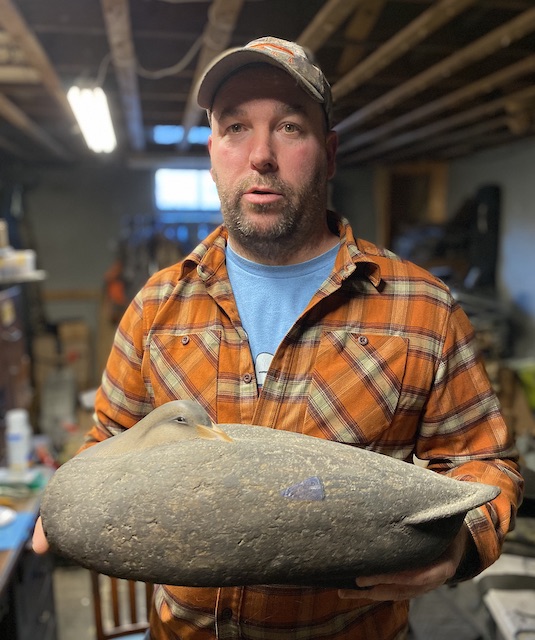
Ramsey Russell: Yeah. It makes perfect sense to me because—anybody listening has heard me say it before—I believe the future of duck hunting lies in its past, for a lot of different reasons. It’s mostly an ethos, a mindset. The practicality of it all. The fundamentals of duck hunting. Look, I’ll drag ultralight decoys and layout boats or whatever it takes to get back in there and hunt them, but I like to hunt over my own hand-carved decoys. I like to hunt over professionally-carved decoys. I like to shoot, sometimes, older guns with a waxed canvas. It’s an aura. It’s just setting back into a different thing. And I understand younger people, I was one too. Duck hunting is a very subjective sport. Why people are duck hunting is varied and sundry.
Mike Braun: I think what happens with a waterfowler is that they start out traditionally, and then they get into the industrial side of it because they want to kill more birds. Then they get to that point—and it’s the point where I’m at— where I did all that. I killed a lot of birds. I don’t need to kill a lot of birds. Now I go back to tradition and get back into how I learned.
Ramsey Russell: It’s a connection. Yes, I agree. The more fundamental you get, the more—to me—intimately connected I am to that resource. My decoys, or this caller, or this handmade decoy. Oh, boy. I see that arc you’re talking about where you start off just wanting to be skillful enough to shoot a duck, to wanting to shoot a bunch of ducks, to wanting to shoot a bunch of ducks all the time, to “I’ve made those piles, now I’m just getting more into the ritual and the tradition.” It’s like maybe anything else, you begin to kind of elevate that sport. Almost like an art form.
Mike Braun: Yeah. As you get older, you’re like, “Wow, I want to go see what the tradition in, say, North Carolina is.” The curtain blinds down there. I would love to go do that. “Let’s go see what a flooded timber hunt is all about.” I think that’s what happens. When you’re young, you’re learning from the old folks. Then as you separate from the older hunters and go on your own, you’re learning what you’re seeing in the industry and what everybody’s doing. They’re seeing huge spreads, big boats, lots of people. Then as you get older—like I said, in my case, I don’t want big spreads and lots of people. I want family and tradition and hunting over what I carved. Just enjoying it. It’s not about the bird. It’s just about being out there.
Traditional New Jersey duck hunting in the modern era?
Ramsey Russell: Describe tomorrow morning’s duck hunt, if you were to go out and hunt. You’d take your dog, Trigger?
Mike Braun: I’d take my dog, my brother, my nephew, and my wife. We’d go out. We got a little spot. Shoot some mallards and wood ducks. It’s simple. Six decoys, that’s it.
Ramsey Russell: It’s inland?
Mike Braun: Yeah, it’s inland. It’s off the Egg Harbor River.
Ramsey Russell: I haven’t seen too many mallards. I’ve seen very few mallards, once you get past the boat ramp, out in the marsh we go to.
Mike Braun: Yeah. Like everything else, the mallards here tend to become residents. If you don’t know where they’re going to feed, it’s all inner city hunting. Our migration push usually doesn’t happen until the last month, month and a half. It just doesn’t get cold enough anymore. So we have all local birds here. You were shooting black ducks and brant. You’ve seen bufflehead and everything. Those birds migrate down early, anyway, and we always have huge concentrations of them because they don’t leave this area until it gets cold. It never gets cold enough for it to freeze like it used to.
Ramsey Russell: That unfortunately seems to be a trend right now, globally. Last year was the first year in recorded history that Moscow, Russia, didn’t have snow on Christmas Day. That affects migration worldwide. The whole Northern Hemisphere, I should say.
Contemporary decoy carver Mike Braun on how-to carve traditional New Jersey-style decoys
Ramsey Russell: All right. Let’s talk about your decoy carving. Walk me through what it takes to carve a decoy. Do you just pick up a block of wood and say, “This is going to be a side head turned—?”
Mike Braun: It starts with a pattern. It depends on what I’m doing. Traditional birds, I have a set pattern. I don’t constantly redraw it. I get my wood already cut. It’s usually four by eight inches thick, and then it’s like six foot long. You just cut it to the size you need. Then you draw your profile from the top and sides. Cut it out on a band saw two ways, so you have the side profile and top profile cut out. Then I just take a draw knife and start making it round.
Ramsey Russell: Really?
Mike Braun: Yeah.
Ramsey Russell: How many hours do you think you got tied up in a gunning decoy?
Mike Braun: A simple gunning decoy I could have roughed out and hollowed and ready to sand for the next day, in a half a day. The stuff for the World’s—like you saw, the teal rig that I did—that was a four month process.
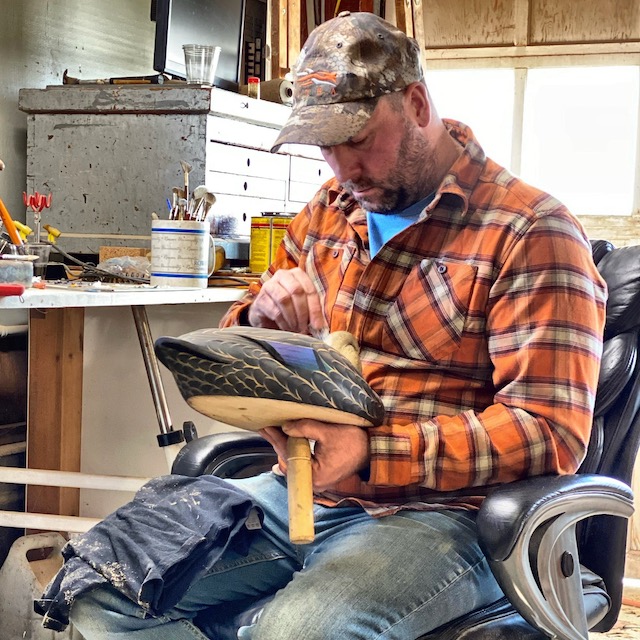
Ramsey Russell: Really?
Mike Braun: Yes. Because you’re carving more detail. You’re putting a lot more paint detail into it. You’re trying to make it look like a duck for a competition.
On putting together and hand-carved waterfowl hunting decoy rig
Ramsey Russell: Sure. I’m just thinking—being in this part of the World—that you do a lot of gunning rigs, a lot of gunning decoys. As expensive as some of these fully-fuzzed decoys seem like, for a four pack or a six pack, duck hunting over hand-carved decoys takes it to a whole new level. How does the average guy begin to put together a gunning rig?
Mike Braun: A lot of my clients that are hunting my birds—they’ll buy like six a year. They just keep building their rig up and building their rig up. Sometimes they get a great bonus, and they say, “Hey, man, make me eight,” or, “Make me ten.” That’s usually how it is. But some guys, say, they only want a pair of mallards, just to spice up their rig. I get a lot of them guys, too.
Ramsey Russell: Buy a couple a year every couple of years; before you know it, you’ve got enough to go out there and hunt. What’s the top species that you sell? Because I walked into your shop, and it’s exactly what I envisioned a New Jersey decoy shop to be. Predominantly black ducks. That’s the first thing I said, “Okay, now I’m in the right spot.”
Mike Braun: A lot of black ducks and a lot of brant.
Ramsey Russell: Yeah. A lot of brant, a lot of black ducks.
Mike Braun: And mallards.
On developing a waterfowl decoy style
Style is a very loose term when it comes to a contemporary carver.
Ramsey Russell: Yeah. Do you have your own style? Because I asked you about this one little brant decoy back here that looks very, very traditional. You said, “No, no, that’s a very traditional New Jersey style.” Since you’ve started with your first decoy at age nine, have you evolved? Have you just developed your own style?
Mike Braun: Style is a very loose term when it comes to a contemporary carver. Which I am a contemporary carver, right? I draw a lot of traditional patterns that are from the Atlantic Flyway, and I carve them. Then I’ll put a spin on them patterns, and add influences from different carvers and stuff like that, and draw other patterns. As far as style, I don’t have any particular one set style. But you can tell that they’re my birds because I’m putting my spin on, say, traditional, contemporary, and decorative. My influence is in everything.
Ramsey Russell: Keeping up with you on social media—I don’t know why I was shocked. I know you compete, and I know you submit different species. To date, some of my favorite decoys that you have carved are those rosybills. I love—I don’t like, I love—rosy-billed pochards. Why did you carve them?
Mike Braun: Same reason. When I did them in 2009, I think I was watching a lot of videos of Argentina hunting. Canvasback is my favorite bird of all, and, just like everybody says, they’re like the canvasback of South America. That’s just why. It’s that big red bill that just turns into the pink, and that contrasts with the black and the grey. A friend of mine had one in the freezer, that’s a taxidermist. She says, “Hey, I got one.” I’m like, “Really?” Then when I saw it in hand, I’m like, “Yeah, I got to carve these.”
Ramsey Russell: And the purple vermiculation, the purple sheen on its head.
Mike Braun: Yeah. The rear iridescence all through the back, which people don’t notice unless you’re really holding the bird. That whole bird’s iridescent.
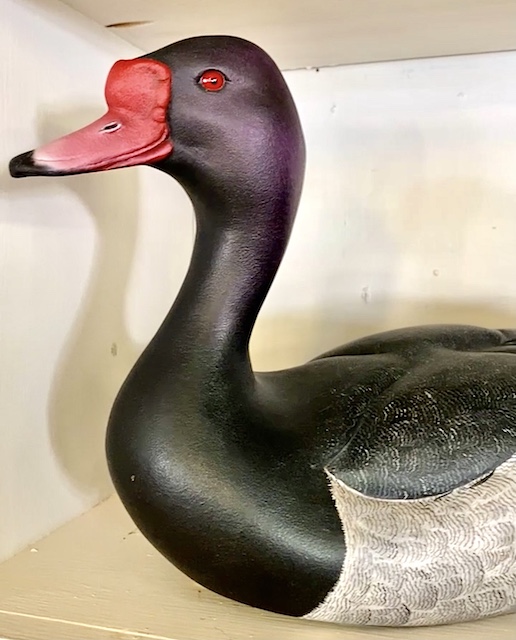
Ramsey Russell: Yeah. What was their reaction when you brought up some rosy-billed pochards for your gunning rig, at the World?
Mike Braun: I got a lot of great reactions.
Ramsey Russell: Had they ever seen it?
Mike Braun: It’s funny. When I talked to the judges, there was only one judge that wasn’t familiar with them. The other judges had actually hunted over them, and then that’s why they picked them for second. It’s tough when you go into competition, and you put a bird in there that they don’t know. Because it’s all North American competition, so they’re not familiar with South American birds. One year I did a New Zealand Scaup, and they didn’t even know what it was. But I wrote on the keel that it was a New Zealand Scaup, so that they could look it up to try to judge it. I just do the competitions for fun, anyway, so I’m going to enter whatever I want.
On carving waterfowl decoys to compete at World Championship level
Ramsey Russell: Sure. I’m thinking there must be some pressure. I know you’re just doing it for fun, but is there any pressure submitting stuff to a world competition? I know it’s got to be extremely competitive. Everybody wants to be world champion.
Mike Braun: It is very competitive. Especially because, in the World’s, you have your bird carvers, and then decoratives, and then all different categories. Just gunning decoys, and whatnot. But even from the ‘70s and ‘80s, when it was around, the contest that everybody wanted to win was the rig competition, which is a three bird rig. That’s a decorative smoothie—which the teal and the pochards, you’ve seen. It gets very competitive. I used to get upset about not placing. Not even just about me, but just seeing birds and going like, “Man, they should have been the winners.” But you never know why they don’t win. You can ask the judges, and they’ll give you some idea, but you never know. It’s like the Olympics. You take a chance.
Ramsey Russell: Does it get in your head? You’re sitting here in a quiet shop at night, and you’ve got your competition birds—
Mike Braun: It used to. I used to plan out these elaborate things, man. I’ve made all kinds of decoy rigs. Sometimes simple is best, and I think I shoot myself because I go over the top. I really get into it. I do. It’s something like, “Man, I want to do this.” Then I’m going to something like—I added a hybrid cinnamon-bluewing. Well, they don’t know how to judge that, but that’s what I wanted to do. The artist in me gets excited to do the rig every year, is what it is.
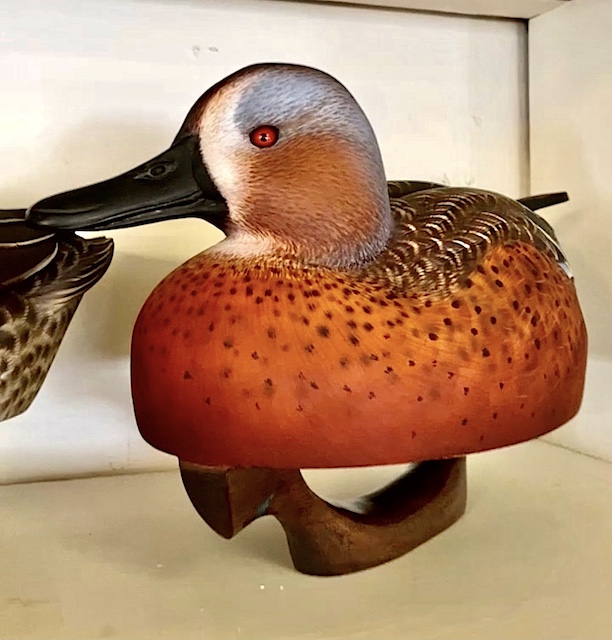
Ramsey Russell: That’s good. How much pressure—or is there any pressure—on turning out birds for clients?
Mike Braun: Uh, there is.
Ramsey Russell: Does your phone ever chirp, and you mess something up and go, “Oh, God”?
Mike Braun: No. A lot of my pressure is just trying to get it out in time for them to have it. That’s the main thing. I always try to do all my gunning birds—that I know people are hunting over—by September, because that’s when the season starts.
Balancing Waterfowl Decoy Carving as an Art and as a Business
An artist is someone that’s expressing their passion about something through their work…But you can’t make a living trying to sell a decoy for nothing, and people are like, “Wow, that’s a lot of money for a decoy.”
Ramsey Russell: Are you an artist?
Mike Braun: I am.
Ramsey Russell: Yeah. How would you define an artist? How would you define yourself as an artist?
Mike Braun: How would I define an artist? An artist is someone that’s expressing their passion about something through their work. I actually went to art school. That’s what I did. I was an illustrator and graphic designer for ten years. Then when we had the economy crash, it was hard for me to hold a job. I ended up in a warehouse.
Ramsey Russell: Back in ‘89? That mortgage thing?
Mike Braun: Yeah. Everybody was having a housing problem and all that. I started the LZ decoy line, which was my molded birds, but that was more work than it was to even carve a regular bird. So I ended up working in a warehouse, or whatever, to make ends meet. Four years ago, they closed the warehouse. I told my wife, “I got so many orders.” I said, “Why don’t I just make a go of decoy carving?” And that’s what we did. I’ve been doing it ever since, and my orders haven’t stopped.
Ramsey Russell: As somebody that used to work for somebody else that now works for myself— I’m trying to think of a saying. It was like, “The great thing about self-employment is you only have to work half a day, but you get to pick which twelve to fifteen hours of that day you want to work.”
Mike Braun: Pretty much. Yeah. My mind doesn’t stop. My mind never stops. From the time I wake up, to the time I fall asleep, I’m thinking about decoys and ducks. I’ve been like that my whole life. It’s kind of like the path finally hit me where I was able to do it.
Ramsey Russell: In a lot of ways, it was almost an opportunity. It was almost a blessing. Was there any pressure to that?
Mike Braun: I had a lot of pressure, because I’m like, “Am I really going to be able to do this?” You don’t know. You don’t know people and money. You can’t make a living trying to sell a decoy for nothing, and people are like, “Wow, that’s a lot of money for a decoy.” Well, think of it this way: how much do you make at your job? That’s the way I look at it. So I price it to what I feel I should get per hour. That’s how I price my birds. Simpler birds are less money and work and time.
Ramsey Russell: I think something you and I have in common is, we’ve also chosen to make lives for ourselves. We got to make a living, but we got to make a life. I value that part of it as much as the living part. Got to pay my bills, but beyond that.
Mike Braun: I wouldn’t be doing any of this if it wasn’t for my family and my wife, to be honest. The support I get is amazing.
Ramsey Russell: Boy, I can tell you what, I can say the same exact thing.
Mike Braun: What we do—being in the waterfowl industry—it’s not for the average person to just say, “Hey, I’m going to do it.” You have to really be dedicated to do it. It’s a seven day job. Seven days a week. Whether two of them days are only six hours, but you’re still doing something. I’m in this shop every day. Whether it’s just doing one little thing to get the order done, and then I’m done for today. Most of the time, I’m in here most of the day.
Ramsey Russell: I thought to ask if you were an artist—and obviously you are—because, when I walked in, I wondered how busy you must be right now with ten or fifteen days before Christmas. You’re like, “I don’t work that way.”
Mike Braun: I don’t. Every once in a while, I have done it in the past when people were like, “Oh man, can I have this for Christmas?” I’m like, “Yeah, if you want to pay a little extra for a rush fee, no problem.” It got to the point where, when I was doing that, other people’s were suffering, so I stopped doing that. Now I do it by a list. I give people an order form to fill out, they fill it out, and then I just go by the list. First one up top. It just keeps going that way. You have to do it that way. You have to look at it as a job.
Ramsey Russell: When I think of New Jersey, and I think of this area—between here, and especially towards Chesapeake Bay, out in this hub of the northeast—I think of traditional decoy carving. I know there’s some in Ohio. We’ve also met with decoy carvers Mark and Luke Costilow, and some other people, on this podcast. Where would you say most of the demand for your product is? Is it nationwide?
Mike Braun: Yeah. Actually, 90% of my sales aren’t even in this state.
Ramsey Russell: Really?
Mike Braun: Yeah.
Ramsey Russell: Is there any one area you’d say, “This area, this geography, seems to have the most”?
Mike Braun: New York. Yep. Because New York guys love hand-carved birds.
Ramsey Russell: That’s right. Order a lot of black ducks?
Mike Braun: Black ducks, brant, even sea ducks. I make a lot of sea duck rigs. New York. Connecticut, a little bit. A lot in Ohio, surprisingly. Pennsylvania. It’s all over. Washington and California and all up the Pacific Northwest, all up there. They don’t have brant decoys, so I make a lot of brant decoys and send them out there for them guys.
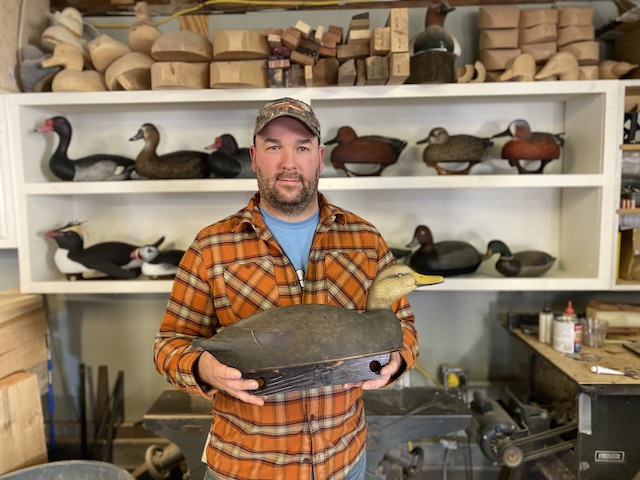
Ramsey Russell: Well, those West Coast brant hunters are real serious guys. Like the serious of the serious. You’ve got to be. There’s just a handful of days those birds are going to skip through. They’re all-in.
Mike Braun: Those birds are there, and then they’re gone. Those guys are hunting there every day, just so they can get their brant. But they’re a good eating bird.
Ramsey Russell: What about brant hunters over here? What about brant over here?
Mike Braun: Oh, it’s big. Again, it’s big here because it’s a migration thing. When you think of New Jersey waterfowl hunting—we get a lot of variety. Wigeon, pintail, gadwall. We do get all them birds, but the majority of the migration that we get is black ducks, brant, broadbills, and sea ducks. That’s now. Way back when in the ‘70s and ‘80s, it was a little different. Everything’s built up, the agriculture changed, the food sources changed, so bird migrations are different now. The bayfront is where most of the action is for us, now.
Hunting Black Ducks in New Jersey
Ramsey Russell: What shocked me, especially coming from Mississippi, is the massive amount of humanity in this part of the world. It’s a lot of folks. We were talking to a game warden the other night, and he threw a number out. Right in this hub, right here: nine million people. I’m like, “You realize that’s three times the entire state population of Mississippi?” It’s a lot of folks. But then you get out from the boat ramp, you get away from those houses—in a mile or two, you’re like, “Whoa, I’ve all of a sudden passed through a time machine. I’m in a whole other era.”
Mike Braun: That’s the one thing that I think separates us from other duck hunting that people are used to seeing, especially on TV or shows. The Atlantic Coast is city limits hunting, but you only have to go out in the bay and turn that corner, and everything disappears. It’s a whole new world, and it’s beautiful. It is very beautiful.
Ramsey Russell: It’s unbelievable. Where we’ve been hunting, we’ve seen a few divers, but the black ducks—holy cow. Forrest and I were talking last night, on the drive back from dinner: how many black ducks do we think we saw? From the time we hunted—the birds that worked, the birds that didn’t—and the boat ride back and the drive back to camp—just out there on that marsh, how many black ducks did we see? 1,000? 1,500? 2,000?
Mike Braun: Easily, and that’s just that one section of marsh. That’s not talking the Delaware River, which you pass over. It’s loaded with black ducks. Black ducks really stage here in New Jersey and New York.
Ramsey Russell: What’s really interesting is how different the black ducks are in a marsh versus Pennsylvania or Ohio. It’s almost like a totally different species.
Mike Braun: It is. Well, it’s not, but the way they act.
Ramsey Russell: Their behavior is totally different.
Mike Braun: Later in the season, like when you get in January—if you shoot a nice red-legged black duck, you did it right. You watch them, and they’ll sit up there, seventy yards up, and they will look at every decoy, look at the rig. They’re not going to come in. They’ll just hover over everything. They get smart. When you get in the city limits, they’re usually the younger black ducks, they’re not like bay black ducks, and they act like mallards. The mallards are a little bit easier to shoot. Yeah, if you get the true bay black ducks, they can be challenging.
Ramsey Russell: Do you have a favorite duck recipe? Do you eat a lot of duck?
Mike Braun: I do eat a lot of duck. Duck poppers that everybody makes. Tacos.
Ramsey Russell: Let’s talk about that. How do you make tacos?
Mike Braun: How do I make tacos?
Ramsey Russell: How do you make duck tacos? It’s just a passion of mine. As I travel around, I like to ask people how they cook duck.
Mike Braun: It’s easy. You just cook it up like you would any other taco. If you use a taco seasoning, use a taco seasoning. I slice it like a fajita. It would be more like a fajita. You cook the breast medium-rare, and then you just slice it real thin.
Ramsey Russell: How might you cook some of these strong ducks that are out in that marsh environment? Poppers and tacos?
Mike Braun: Yeah. Poppers, mostly. Jalapeño wrapped with bacon, and pepperjack cheese on top.
Ramsey Russell: You could wrap just about anything in that. I’m thinking a dog turd would probably taste good wrapped in bacon. It’d be hard to beat that.
Mike Braun: Like you said, black ducks—I tend not to shoot the black ducks because they’re really strong. We were talking about that earlier. Brant—there’s a trick to know whether you can eat that brant or not. You flip them—I hate to say it—but if you flip them upside down, and it’s got a green butthole, that’s not good. He’s been eating the cabbage. The best time to eat the brant, here, is when they first come here. Because we used to have a lot of eelgrass, and we don’t have the eelgrass like we used to. So when they get here, they’re eating all the snails and all the cabbage.
Ramsey Russell: They’re eating what they can.
Mike Braun: Yeah, so they get really strong. But as long as you cook them like a regular piece of steak, medium-well, they’re edible. They’re not bad.
Ramsey Russell: Out West, the black brant—Pacific brant—is absolutely delicious. More eel grass out there. I’ve always heard that these Atlantic brant aren’t any good, that we don’t even hunt them because they’re no good to eat.
Mike Braun: The young ones are the best ones to eat, for sure.
Ramsey Russell: We walked in the other day, and our host had this big bowl of meat slices. We’re nibbling on it. He said, “I’m glad you enjoyed it. That’s brant.” He said, “Everybody says it’s no good.” He was going to show us, tonight and tomorrow, how he marinates them before he grills them and slices them real good. I said, “Man, we got to do something on this because everybody says they’re no good to eat.” Somebody online even said, “He’s pulling your leg. That’s chuck roast or something, not brant.”
Mike Braun: It’s like everything else. You just got to cook them right. People make fun of me. “Bufflehead, you can’t eat bufflehead.” Bufflehead is a phenomenal eating bird.
Ramsey Russell: Yeah. I’ll get Forrest on here, one day, for his bufflehead recipes. He and his college roommates put away a lot of bufflehead.
Mike Braun: They are a good eating bird. They’re very underrated. Hooded merganser tastes just like bufflehead—people don’t know that—because they eat the same thing as a bufflehead. They think they’re just eating fish, but they’re actually eating crustaceans. They eat the crabs and all that stuff.
Ramsey Russell: I don’t shoot mergansers, to speak of, and now that you said that I’m wondering— I just ain’t going to shoot hooded mergansers. Generally speaking, I’m not going to shoot mergansers.
Mike Braun: Common mergansers and red-breasted mergansers you can’t eat. They’re really strong. But hooded mergansers, they’re not bad. You can eat them.
Unique Waterfowl Decoy Rigs
Ramsey Russell: Mike, what are some of the most exotic—not your competition birds, but for clients—some of the most exotic rigs, or different rigs, you’ve put together? Do you put together bufflehead rigs?
Mike Braun: I don’t carve that many bufflehead, actually. No. I don’t carve a lot of bufflehead. I do a lot of scoters.
Ramsey Russell: Common scoters?
Mike Braun: Well, it would be a mix. It may be, say, half a dozen blacks and half a dozen scoters with a couple of white wings mixed in, or something. I made an eider rig last year. I do some hybrids and stuff like that for people that want to put it in their rig. But, typically, it’s typical stuff. It’s nothing really exotic.
Ramsey Russell: Just whatever the customer wants.
Mike Braun: Yeah. Pretty much. The common species that they’re going to hunt ever. Mallards, black ducks, that kind of stuff. I did a pair of geese. One was an urn. My customer hunted over them.
Ramsey Russell: Wow. Do you do a lot of urns like that?
Mike Braun: I do make a lot of urns.
Ramsey Russell: I think it’s a great idea. I’ve buried a lot of dogs, but the only dog I’ve got in my life right now—I’ve thought about a ringneck urn. Just one particular memory of her rooting out a couple of drake ringnecks on one particular hunt, it’s just always stayed with me. And we shoot a lot of them at times, down in Mississippi. I think that’d be a great tribute to her.
Mike Braun: Yeah. I think that when Trigger passes he’s probably going to go in a goose, because he’s obsessed with geese. He loves geese. Out of anything that he retrieves, geese are his thing. He just goes nuts when he goes after a goose. I think because it’s big and feathery. He loves it.
Ramsey Russell: Well, he’s built kind of like a linebacker.
Mike Braun: Yeah. He’s got a lot of heart. He’s ten years old now.
Ramsey Russell: Really? I never would have guessed that he’s that old.
Mike Braun: Yeah, he’s ten. He still goes strong.
Ramsey Russell: That’s good. Have you got your eye on another dog yet?
Mike Braun: No, not yet. That’s a hard one. Everybody keeps asking me, “Are you going to start thinking about getting another pup?” Say, “I don’t know, man. He’s still hunting hard, and he’s really attached to me. I feel like I’d be breaking his heart.” So I don’t know. We’ll see.
How Does Duck Hunting in New Jersey Compare to Elsewhere
The decoy history here in New Jersey is really something.
Ramsey Russell: Have you hunted ducks and geese much, outside of New Jersey?
Mike Braun: I’ve been to a couple of places. I went to the Finger Lakes one year. That was my first trip that I ever took out of state. Shooting redheads and whatnot. That was a lot of fun.
Ramsey Russell: Right in the backyards? We went on one a couple weeks ago, we were hunting right in their backyard. It was unbelievable.
Mike Braun: That’s pretty much how they hunt. It was a boat dock, actually. You’re literally like hunting underneath a boat dock. But the laws up there are crazy. You’re allowed to hunt like that.
Ramsey Russell: Yeah. I didn’t mind a bit.
Mike Braun: I went to Lake Seminole. Sculled on canvasbacks on Lake Seminole, which was a blast. Had fun. We shot some coot and gadwalls and stuff like that. I never got those. We see coot, but we don’t really shoot them. I’m trying to think where else I went. New York. Hunted in New York, on Long Island, with a friend of mine. The recent hunt that I went on was my dad’s last hunt, which was to Texas.
Ramsey Russell: Which part of Texas?
Mike Braun: Corpus Christi. Shooting redheads. He had never shot a redhead, so that was the goal, was for him to get a redhead. He was able to shoot a pair of redheads, which was nice.
Ramsey Russell: I was curious how you would compare hunting elsewhere to hunting right here in your backyard.
Mike Braun: It’s strange. Well, it’s not strange, but it’s just different. Like I’m going to Arkansas—on Monday we leave, we drive down—and I know that’s going to be a totally different animal. I don’t know what to expect. They say flooded rice fields and pits and flooded timber. Well, we kind of hunt flooded timber here, too, for wood ducks and mallards, but I know it’s a whole different game out there. It’s going to be exciting. It’ll be fun. I’ve never shot a speck before.
Ramsey Russell: Oh boy, they got them. They sure do. I’ve always wanted to come to New Jersey, just having been aware of the history. The Barnegat Bay and the black ducks. Just the tradition around this area.
Mike Braun: The decoy history here in New Jersey is really something.
Ramsey Russell: And the market gunning history, and back in the day. From here to Chesapeake Bay just makes me think of the cradle of North American duck hunting.
Mike Braun: Well, they say the Chesapeake is the decoy capital of the world, right?
Ramsey Russell: Oh, yeah. So that’s what put it on my radar. As you start talking to people that have come to New Jersey to hunt—gosh, I got an inbox this morning from some young folks in South Carolina, younger than me, who recognized my truck and just wanted to meet up with me. They’ve been coming here for years. Then there’s some buddies of mine in Pennsylvania and around. The hunting quality is good. I just wondered if you’re traveling around—I love to see different places, but—if you’re ever traveling and gotten outside your backyard and looked back and said, “We’ve got it pretty dang good in New Jersey.” Because you do. A lot of public land.
Mike Braun: We do. There is. If you do your research, and you really look at the laws, there’s a lot of places to hunt. There really is. Yeah. It’s tough. We do have a lot of refuges here, and a lot of the migration going to refuges. Birds are smart that way. They know they’re not getting bothered there. But you pick your battles. The one thing about hunting here is the population. It’s such a small state and such a huge abundance of waterfowlers. You really got to do your homework, and it’s pretty much a race to get to your spot. You got to get up early and be there. But the spots are there. The birds are there,
Ramsey Russell: They are. We’ve had a couple of good days. Got a couple of more days we’re looking forward to. I love it. Real New Jersey duck hunting has been an amazing experience. One of the gentlemen we hunt with actually hunts out of a power boat but uses a small spread of decoys that he and his buddies have carved. Might throw out a dozen of them. Another guy we hunt with, he’s got a complete other philosophy. He’s like, “Uh-uh. I want a bunch.” He puts a bunch of them out.
Mike Braun: That goes back to what we were describing earlier. I did the whole bunch of decoys. Now, I’m going back to simple.
Ramsey Russell: Going back to simple.
Mike Braun: But a lot of times, I think the smaller spreads work better. Especially if they’re hand-carved. They look different, and they float different.
Ramsey Russell: Well, I know a lot of the black ducks we’ve seen have been in pairs and little family cohorts. Nothing big. We’ve seen some big ones, but mostly small.
Mike Braun: The only time you see a really huge mass of black ducks is when everything freezes up and they have nowhere to go. But if you’re going up the ditches, there’ll be no more than four birds together at every hundred yards. They don’t really congregate together in big masses. There’ll be a lot of birds in the area, but with all the potholes and the ditches and places for the birds to go, they just kind of spread out everywhere. That’s the hard part about hunting them.
Contact New Jersey Decoy Carver Mike Braun, MRB Decoys Art Design
Ramsey Russell: Mike, how can people listening get in touch with you? How can they connect with you on social media?
Mike Braun: They can follow my Facebook page @MRBDecoysArtDesign. They can contact me on my website, which is MRBDecoysArtAndDesign.com. Just look me up on Facebook too. I’m on Instagram @mrb.decoys_art_design. Mike Braun MRB Decoys and Art Design.
Ramsey Russell: Folks, y’all have been listening to Mike Braun from New Jersey. Decoy carver. Check him out. Y’all will really enjoy looking at his photos and seeing what he does. He does a really nice job of posting pictures and stuff like that, and now you kind of know the rest of the story. What inspired him to carve decoys like this, in this part of the world. Anyway, thank y’all for listening to this episode of Duck Season Somewhere. Next episode, we’re still in New Jersey. Thank y’all.




